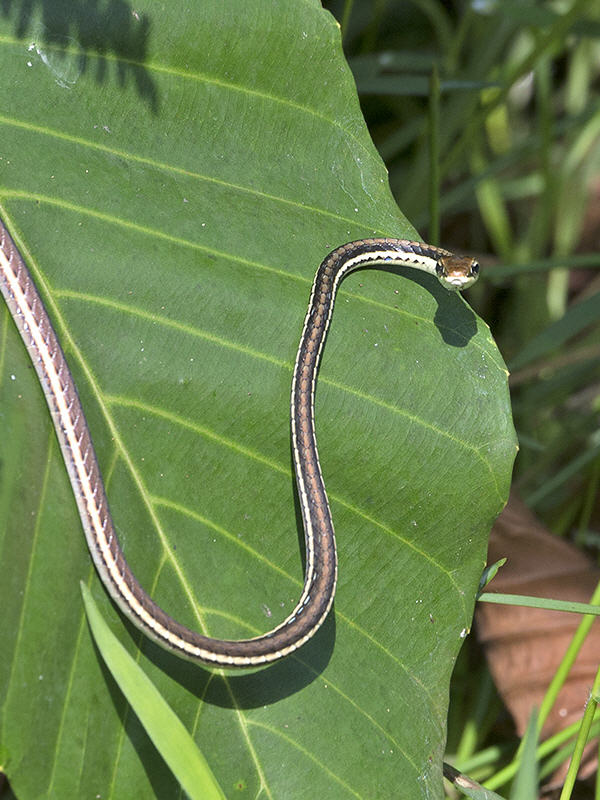
Fig 1

Fig 2

Fig 3

Fig 4

Fig 5
 |
Family : COLUBRIDAE
Species: Dendrelaphis pictus
Maximum Size : 125 cm
The Painted Bronzeback
Dendrelaphis pictus is a widespread and adaptable species occurring
in a broad range of habitats. In its native habitat it is probably a forest
edge species, as it is rarely encountered in dense forest. It has
adapted to a broad range of disturbed and man-made habitats including
secondary scrub, parks and gardens.
It is fully diurnal - by day it actively searches for its food prey, which
comprises mainly lizards and frogs, but by night it rests on narrow tree
branches a few metres above the ground.
This snake is nervous in disposition, and will typically flee swiftly when
disturbed.
The top of its head is brown to
bronze, and there is a black eye-stripe which extends along the neck and a
short distance down the body. There is a cream and black stripe along the
flanks. The larger, vertebral scales, which run along the full length of the
body, may be brown or olive-grey.
When threatened, or when consuming prey, this snake will inflate its body slightly
to reveal bluish or turquoise skin underlying its body scales.
Its head is slightly larger than its moderately slender body, and its eyes
are large, typically with a brown iris.
This wide-ranging snake ranges occurs in at least Myanmar, Thailand, Indochina (Vietnam,
Laos, Cambodia), Peninsular Malaysia, Singapore, Sumatra, Java and Borneo.
Populations in Philippines and Sulawesi which were formerly referred to
Dendrelaphis pictus are now referred to Dendrelaphis marenae
(Vogel & van Rooijen, 2008).
Fig 1 : An example from Upper Seletar, Singapore, warming itself in the
morning sun at the edge of secondary swamp forest.
Fig 2 : This juvenile example was found sunning itself on an exposed tree
root in secondary forest, Singapore.
Fig 3 : Resting by night amongst palm leaves in
a leafy suburb of Singapore.
Fig 4 : Exploring a fishtail palm, probably for
geckos or other lizards. This is a typical specimen from Singapore, with
brown vertebral scales.
Fig 5 : Devouring a
Copper-cheeked Frog Chalcorana cf. labialis
in Singapore's central forests.
Fig 6 : Specimen from Battambang, Cambodia, with olive-grey vertebral
scales and strongly bronze head. Photo thanks to Ian Prothero.
Fig 7 : At night this species typically rests on slender branches a few
metres from the ground.
References :
Cox, van Dijk, Nabhitabhata, Thirakhupt, 1998. A photographic Guide to
Snakes and Other Reptiles of Peninsular Malaysia, Singapore and Thailand.
New Holland.
Vogel, G. & van Rooijen, J. (2008). Contributions to a review of the
Dendrelaphis pictus (Gmelin, 1789) complex - 2. the eastern forms.
Herpetozoa, 21(1/2), 3-29.
|